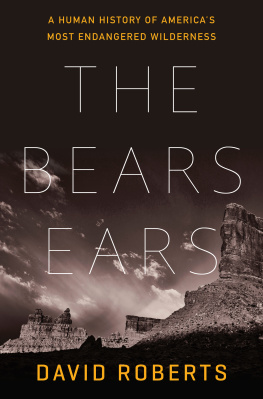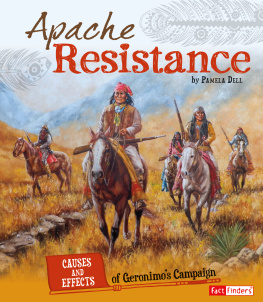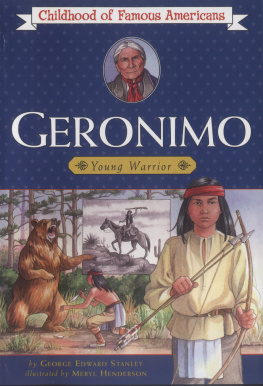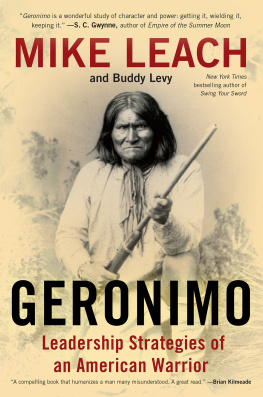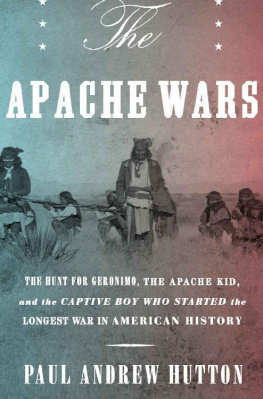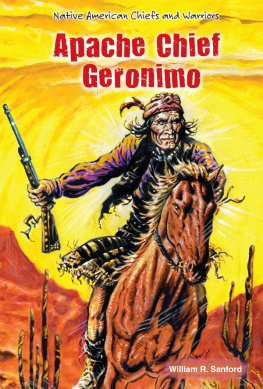Once They Moved Like the wind
Cochise, Geronimo, and the Apache Wars
David Roberts
A TOUCHSTONE BOOK
Published by Simon & Schuster
New York London Toronto
Sydney Tokyo Singapore

TOUCHSTONE
Rockefeller Center
1230 Avenue of the Americas
New York, New York 10020
www.SimonandSchuster.com
Copyright 1993, 1994 by David Roberts
All rights reserved
including the right of reproduction
in whole or in part in any form.
First Touchstone Edition 1994
TOUCHSTONE and colophon are registered trademarks of Simon & Schuster Inc.
Designed by Karolina Harris
Manufactured in the United States of America
10 9 8 7 6 5 4
Library of Congress Cataloging-in-Publication Data
Roberts, David, date.
Once they moved like the wind; Cochise, Geronimo, and the Apache wars I David Roberts.
p. cm.
Includes bibliographical references (p. ) and index.
1. Cochise, Apache chief, d. 1874. 2. Geronimo, 1829-1909. 3. Apache IndiansBiography. 4. Apache IndiansWars. 5. Apache IndiansHistory. I. Title.
E99.A6C575 1993
973.04972dc20
[B] 93-7112 CIP
ISBN 0-671-88556-1
eISBN 978-1-4516-3988-9
To the living Apache of Arizona, New Mexico, and Oklahoma
In sorrow at what they lost, and awe at what they saved
Contents
Once I moved about like the wind. Now I
surrender to you and that is all.
Geronimo
on surrendering to General George Crook
Preface
A t the end, in the summer of 1886, they numbered thirty-four men, women, and children under the leadership of Geronimo. This small group of Chiricahua Apaches became the last band of free Indians to wage war against the United States government. The renegades, as white men called them, were mercilessly pursued by five thousand American troops (one-quarter of the U. S. Army) and by some three thousand Mexican soldiers. For more than five months Geronimos band ran the soldiers ragged. The combined military might of two great nations succeeded in capturing not a single Chiricahua, not even a child.
The odyssey of those fugitive Apaches ran its course, to be sure, as a hopeless cause. Yet in its melancholy inevitability, the struggle of Geronimos band wrote a logical end to a quarter century of betrayal and misunderstanding. For their refusal to give in, the Chiricahua were punished as no other native people in U. S. history has ever been.
The story of the Chiricahua resistance is one of the most powerful of American narratives. In its essential features, it sings the perennial themes of both epic and tragedy, as the ancient Greeks defined those genres. Hundreds of books have been written about the Apaches, yet few seem to have grasped the basic shape of their story. All too often the telling bogs down in the details of troop deployments and Indian raids. The human character of the struggles protagonistsboth white and Apachegoes unilluminated.
Like most cultural tragedies, the war between the United States and the Chiricahua was founded on fundamental errors of perception. Scouts, soldiers, and statesmen came away from years of experience with the Apache convinced they had probed to the core of his nature. What these experts saw, of course, was the shimmer of their own befuddled preconceptions. A sampler of their pronouncementsthe examples could be multiplied indefinitelymakes rueful reading today.
like a people who know no God nor that there is any hell.
SPANISH MISSIONARY (ca. 1660)
the prairie wolfsneaking, cowardly, and revengeful. They are always ready to assassinate women and children.
TRAVELER SAMUEL WOODWORTH COZZENS (1858)
on the continent. Treacherous, bloodthirsty, brutal with an irresistible propensity to steal.
INDIAN AGENT GEORGE BAILEY (1858)
two emotions, fear and hate.
LIEUTENANT WALTER SCRIBNER SCHUYLER (1873)
, cruel, deceitful and wholly irreclaimable.
GENERAL JOHN POPE (1880)
upon his victim like a snake in the grass; if he can capture him he invariably tortures him to death, but otherwise he scalps and mutilates him in the most horrible manner, and has never been known to show the smallest trace either of humanity or good faith.
EXPLORER WILLIAM A. BELL (1870)
Indians can count much beyond ten, but the Apaches can count to 10,000 as easily as we do.
ARIZONA HISTORIAN (1884)
and shrewdest animals in the world, with the added intelligence of human beings.
MAJOR WIRT DAVIS (1885)
death without so much as a grunt, while imprisonment is a terror to him.
NEWSPAPER REPORTER (1886)
The cardinal failing of most accounts of the Apache resistance has been an inability to comprehend its doleful history from the Chiricahua point of view. No chronicler today would echo the racist calumnies of the nineteenth-century witnesses quoted above. But since the 1960s, our guilt-ridden culture has indulged in a reverse stereotype, a sentimental idealization of the American Indianthe noble sage, living in harmony with the landthat represents a comparable failure of the imagination.
Thanks to the labors of such scholars as Grenville Goodwin, Morris Opler, Keith Basso, D. C. Cole, Angie Debo, and the remarkable Eve Ball, non-Apaches are in a better position than ever before to understand the Chiricahua tragedy from the Apache point of view. Nor can we continue to excuse the cardboard cutouts, however striking, that substitute in our narratives for the real men and women who waged that struggle.
Cochise himself will always seem somewhat elusive: it is hard to probe beneath the legend, borne out in detail after detail, of the finest Apache leader on record. In recent years, however, there has been a movement to downplay Geronimos importance, to minimize his deeds as overrated. Revisionist scholars compare him unfavorably to such less celebrated Apache leaders as Juh and Victorio.
This book resists such revisionism. In part because he lived into the twentieth century, Geronimo left us a rich trove of anecdote and testimony. No more interesting or contradictory figure crossed the stage of Western history in the second half of the nineteenth century. To be sure, as his detractors point out, Geronimo was not even a chief; yes, he could be manipulative, vain, vengeful, and cruel; granted, at times he verged on the comic or the pathetic. For all that, Geronimo stands astride the desert Southwest, haunting our collective nightmare of Manifest Destiny. As most of the living Apache see him today, so this narrative attempts to paint him: as one of the heroes of American history.



